
NEW YORK — On the 77th floor of One World Trade Center, in an office with panoramic views of Manhattan, executives from pharma and biotech companies like Regeneron and Merck heard the pitch: Please help us study GLP-1s in Parkinson’s disease.
With the explosion in popularity of diabetes and weight loss drugs like Ozempic and Zepbound, GLP-1 receptor agonist drugs have been hyped as potential miracle cures for many diseases. GLP-1s are being studied for cardiovascular disease, liver conditions, kidney disease, and Alzheimer’s. Older approved GLP-1s from Novo Nordisk, Sanofi, and Amylin have been or are being explored for Parkinson’s.
But amid all the jostling to find the next use case for GLP-1s, the proposition in October — the day before the Michael J. Fox Foundation’s annual meeting in New York — came from an unlikely source: Koneksa Health, which helps drug developers use smartphone apps and wearables to study whether their treatments work. Koneksa hatched a plan to study GLP-1 with its tools after researchers in April published results of a randomized control trial showing that people with Parkinson’s on Sanofi GLP-1 drug Lixisenatide saw no worsening of motor symptoms over a year, compared to those on placebo who did.

This article is exclusive to STAT+ subscribers
Unlock this article — and get additional analysis of the technologies disrupting health care — by subscribing to STAT+.
Already have an account? Log in






